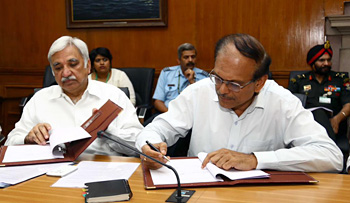INDIAN ARMED FORCES CHIEFS ON OUR RELENTLESS AND FOCUSED PUBLISHING EFFORTS

SP Guide Publications puts forth a well compiled articulation of issues, pursuits and accomplishments of the Indian Army, over the years

"Over the past 60 years, the growth of SP Guide Publications has mirrored the rising stature of Indian Navy. Its well-researched and informative magazines on Defence and Aerospace sector have served to shape an educated opinion of our military personnel, policy makers and the public alike. I wish SP's Publication team continued success, fair winds and following seas in all future endeavour!"

Since, its inception in 1964, SP Guide Publications has consistently demonstrated commitment to high-quality journalism in the aerospace and defence sectors, earning a well-deserved reputation as Asia's largest media house in this domain. I wish SP Guide Publications continued success in its pursuit of excellence.
Skill Development and Armed Forces
 |
By Lt. General P.C. Katoch (Retd) Former Director General of Information Systems, Indian Army |


Photo Credit: MoD
NR Narayan Murthy recently said, “Is there one invention from India that has become a household name in the globe? No such contribution in the last 60 years.” The social media went hyper dubbing him a cynic, perhaps his statement was adjunct to what the head of Drona School of Engineering said, “We need to not just Make in India, but Create in India, Design in India and Innovate in India, so as to create and own all the intellectual property and operate independently." As per the National Skill Development Corporation (NSDC), there was just two percent growth in employable skills in the engineering sector last year and the situation was worse in polytechnics as not even one-third of the students could match the benchmark levels. 61% of employers surveyed in India during 2013 blamed insufficient skills that prevented them from filling vacant positions in companies. Ironically, just 14% of India's workforce has good inter-personal skills while only 10% has communication skills.
The bottom-line is we have a colossal void of skilled manpower in the country. Our technical teaching institutions have curriculums that are super heavy on theory, little practical. As per an NSDC report: India needs 500 million skilled in various sectors over next five years; construction and real estate sectors need additional 41 million workforce by 2022; additional 28.4 million strong workforce is required in transportation, logistics, warehousing and packaging sector by 2022, and, the scene is similar health, media, agriculture, education, IT, handloom, retail etc. However, till 2013, only 1.4 million were trained against the skilling target of 8.5 million. Obviously, we don’t have skilled manpower and technical curricula to facilitate the 'Make in India' vision. It is in this context that Prime Minister Narendra Modi recently launched the ambitious Skill India Initiative that aims to train 40 crore people by 2020. Concurrently, a MoU between the MoD and the Ministry of Skill Development and Entrepreneurship (MSDE) has been signed to facilitate strategic partnership on skill development and entrepreneurship for supporting skill development initiative to contribute towards Nation Building and ‘Make-in-India’ initiative.
The aim is to provided impetus to using the skills of servicemen for the country when they retire from the Armed Forces. The MoS for MSDE has said that there are differences in nomenclature of jobs in certain cases that the servicemen do in the Armed Forces and in the civilian field and these need to be aligned. To enhance the employability of retiring or veterans, training facilities initiated by the Director General Resettlement (DGR) will be aligned with the National Skills Qualifications Framework (NSQF) developed by the Sector Skill Councils (SSCs). The MoU aims to provide opportunity for the DPSUs and OFs to participate in skill development initiatives. As per Ministry of Human Resources Development Scheme in schools which are run by the Ministry of Defence (excluding Sainik Schools), it will also introduce vocational education at 9 12 class in a phased manner. Target for the MoU is to train and gainfully employ some three lakh ESM / their family members over a period of five years, also making available skilled youth to DPSUs and OFs by using their infrastructure, CSR funds, establishment of Centre(s) of Excellence and Development of Model ITIs etc. For successful execution of the scheme, three separate implementation teams have been formed:
- DGR will head the ESM resettlement team;
- DPSUs related components will be looked after by the Joint Secretary (ES), DoPD, and;
- Respective education boards of Army, Navy and Air Force will lead their respective education component.
Theoretically, the MoU looks good but the proof lies in its implementation. Some 70,000 well disciplined military personnel retire annually, 60,000 from army alone. The DGR is not equipped to provide training to such large numbers. The military has been deliberately kept out of the MoD, DRDO, DPSUs and staff in these organizations being averse to military and the veterans is an established fact. Non-implementation of OROP apart, ongoing court cases against war widows, disabled soldiers and veterans itself are ample proof. Changing this culture will be a herculean task. Some insurgency affected states are offering employment to veterans in police forces but if veterans were to get back to CI, they would have preferred to join RR. Lateral induction in CAPF pan India is an option the government could consider but politics would probably prohibit taking such step.





